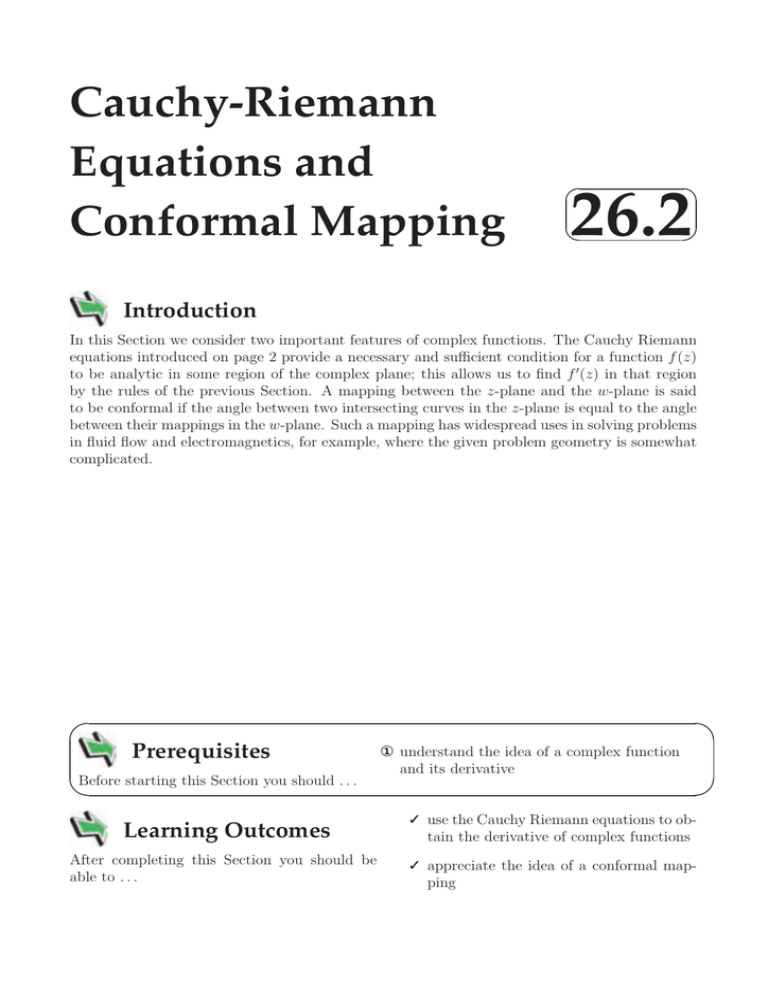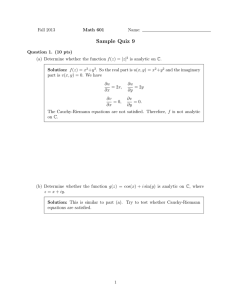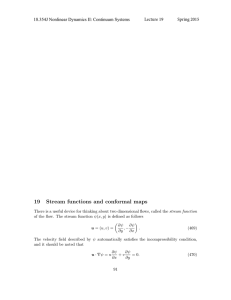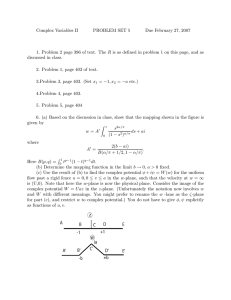Cauchy-Riemann Equations and Conformal Mapping
advertisement

Cauchy-Riemann Equations and Conformal Mapping 26.2 Introduction In this Section we consider two important features of complex functions. The Cauchy Riemann equations introduced on page 2 provide a necessary and sufficient condition for a function f (z) to be analytic in some region of the complex plane; this allows us to find f (z) in that region by the rules of the previous Section. A mapping between the z-plane and the w-plane is said to be conformal if the angle between two intersecting curves in the z-plane is equal to the angle between their mappings in the w-plane. Such a mapping has widespread uses in solving problems in fluid flow and electromagnetics, for example, where the given problem geometry is somewhat complicated. Prerequisites Before starting this Section you should . . . ① understand the idea of a complex function and its derivative Learning Outcomes ✓ use the Cauchy Riemann equations to obtain the derivative of complex functions After completing this Section you should be able to . . . ✓ appreciate the idea of a conformal mapping 1. Cauchy-Riemann equations Remembering that z = x+iy and w = u+iv we note that there is a very useful test to determine whether a function w = f (z) is analytic at a point. This is provided by the Cauchy-Riemann equations. These state that w = f (z) is differentiable at a point z = z0 if, and only if, ∂v ∂u = ∂x ∂y and ∂u ∂v =− ∂y ∂x at that point. When these equations hold then it can be shown that the complex derivative may be determined df ∂f df ∂f by using either = or = −i . dz ∂x dz ∂y (The use of ‘if, and only if,’ means that if the equations are valid, then the function is differentiable and vice versa). If we consider f (z) = z 2 = x2 − y 2 + 2ixy then u = x2 − y 2 and v = 2xy so that ∂u = 2x, ∂x ∂u = −2y, ∂y ∂v = 2y, ∂x ∂v = 2x. ∂y It should be clear that, for this example, the Cauchy-Riemann equations are always satisfied; therefore, the function is analytic everywhere. We find that df ∂f = = 2x + 2iy = 2z dz ∂x or, equivalently df ∂f = −i = −i(−2y + 2ix) = 2z dz ∂y This is the result we would expect to get by simply differentiating f (z) as if it was a real function. For analytic functions this will always be the case. Example Show that the function f (z) = z 3 is analytic everwhere and hence obtain its derivative. Solution w = f (z) = (x + iy)3 = x3 − 3xy 2 + (3x2 y − y 3 )i Hence u = x3 − 3xy 2 Then ∂u = 3x2 − 3y 2 , ∂x and v = 3x2 y − y 3 . ∂u = −6xy, ∂y ∂v = 6xy, ∂x ∂v = 3x2 − 3y 2 . ∂y The Cauchy-Riemann equations are identically true and f (z) is analytic everywhere. Furthermore ∂f df = = 3x2 − 3y 2 + (6xy)i = 3(x + iy)2 = 3z 2 as we would expect. dz ∂x We can easily find functions which are not analytic anywhere and others which are only analytic in a restricted region of the complex plane. Consider again the function f (z) = z̄ = x − iy. Here HELM (VERSION 1: April 8, 2004): Workbook Level 2 26.2: Cauchy-Riemann Equations and Conformal Mapping 2 u = x so that ∂u = 1, and ∂x ∂u = 0; ∂y v = −y so that ∂v = 0, ∂x ∂v = −1. ∂y The Cauchy-Riemann equations are never satisfied so that z̄ is not differentiable anywhere and so is not analytic anywhere. 1 By contrast if we consider the function f (z) = we find that z y x ; v= 2 . u= 2 x + y2 x + y2 As can readily be shown, the Cauchy-Riemann equations are satisfied everywhere except for 1 x2 + y 2 = 0, i.e. x = y = 0 (or, equivalently, z = 0). At all other points f (z) = − 2 . This z function is analytic everywhere except at the single point z = 0. Analyticity is a very powerful property of a function of a complex variable. Such functions tend to behave like functions of a real variable. Example Show that if f (z) = z z̄ then f (z) exists only at z = 0. Solution f (z) = x2 + y 2 so that u = x2 + y 2 , ∂u = 2x, ∂x ∂u = 2y, ∂y v = 0. ∂v = 0, ∂x ∂v = 0. ∂y Hence the Cauchy-Riemann equations are satisfied only where x = 0 and y = 0, i.e. where z = 0. Therefore this function is not analytic anywhere. Analytic Functions and Harmonic Functions Using the Cauchy-Riemann equations in a region of the z-plane where f (z) is analytic, ∂ ∂u ∂ ∂v ∂2v ∂2u = = − =− 2 ∂x∂y ∂x ∂y ∂x ∂x ∂x and ∂ ∂u ∂ ∂v ∂2v ∂2u = = = 2. ∂y∂x ∂y ∂x ∂y ∂y ∂y If these differentiations are possible then ∂2u ∂2u + =0 ∂x2 ∂y 2 ∂2u ∂2u = so that ∂x∂y ∂y∂x (Laplace s equation). In a similar way we find that ∂ 2v ∂2v + = 0 (can you show this?) ∂x2 ∂y 2 When f (z) is analytic the functions u and v are called conjugate harmonic functions. 3 HELM (VERSION 1: April 8, 2004): Workbook Level 2 26.2: Cauchy-Riemann Equations and Conformal Mapping Suppose u = u(x, y) = xy then it is easy to verify that u satisfies Laplace’s equation (try this). We now try to find the conjugate harmonic function v = v(x, y). First, using the Cauchy-Riemann equations: ∂u ∂v = =y ∂y ∂x and ∂v ∂u =− = −x. ∂x ∂y 1 Integrating the first equation gives v = y 2 + a function of x. Integrating the second equation 2 1 2 gives v = − x + a function of y. Bearing in mind that an additive constant leaves no trace 2 after differentiation we pool the information above to obtain 1 v = (y 2 − x2 ) + C 2 where C is a constant 1 Note that f (z) = u + iv = xy + (y 2 − x2 )i + D where D is a constant (replacing Ci). 2 1 2 We can write f (z) = − iz + D (as you can verify). This function is analytic everywhere. 2 Show that the function u = x2 − x − y 2 is harmonic. Your solution Hence ∂2u ∂2u + = 0 and u is harmonic. ∂x2 ∂y 2 ∂u = 2x − 1, ∂x ∂2u = 2, ∂x2 ∂u = −2y, ∂y ∂2u = −2. ∂y 2 Now find the conjugate harmonic function v. Your solution HELM (VERSION 1: April 8, 2004): Workbook Level 2 26.2: Cauchy-Riemann Equations and Conformal Mapping 4 5 HELM (VERSION 1: April 8, 2004): Workbook Level 2 26.2: Cauchy-Riemann Equations and Conformal Mapping 1. f (z) is singular at z = 2i. Elsewhere f (z) = (z − 2i).1 − z.1 −2i = (z − 2i)2 (z − 2i)2 f (−i) = −2i −2i 2 = = i (−3i)2 −9 9 2. u = x2 + x − y 2 and v = 2xy + y ∂u = 2x + 1, ∂x ∂u = −2y, ∂y ∂v = 2y, ∂x ∂v = 2x + 1 ∂y Here the Cauchy-Riemann equations are identically true and f (z) is analytic everywhere. ∂f df = = 2x + 1 + 2yi = 2z + 1 dz ∂x 3. Show that the function u = x2 − y 2 − 2y is harmonic, find the conjugate harmonic function v and hence find f (z) = u + iv in terms of z. 2. Show that the function f (z) = z 2 +z is analytic everywhere and hence obtain its derivative. and evaluate f (−i). 1. Find the singular point of the rational function f (z) = z . Find f (z) at other points z − 2i Exercises f (z) = u + iv = x2 − x − y 2 + 2xyi − iy + D, Now z 2 = x2 − y 2 + 2ixy and z = x + iy D constant f (z) = z 2 − z + D. thus Your solution Finally, find f (z) in terms of z. ∂v ∂v = 2x − 1 gives v = 2xy − y+ function of x. Integrating = +2y gives Integrating ∂y ∂x v = 2xy+ function of y. Ignoring the duplication, v = 2xy − y + C, where C is a constant. f (z) = x2 + 2ixy − y 2 + 2xi − 2y = z 2 + 2iz ∴ v = 2xy + 2x + constant ∂u ∂v =− = 2y + 2 ∂x ∂y ∂v ∂u = = 2x ∂y ∂x 3. ∂2u = 2, ∂x2 therefore v = 2xy + 2x+ function of x therefore v = 2xy+ function of y ∂2u = −2 ∂y 2 therefore u is harmonic. 2. Conformal Mapping In Section 1 we saw that the real and imaginary parts of an analytic function each satisfies Laplace’s equation. We shall show now that the curves u(x, y) = constant and v(x, y) = constant intersect each other at right angles (we say that they are orthogonal). To see this we note that along the curve u(x, y) = constant we have du = 0. Hence du = ∂u ∂u dx + dy = 0. ∂x ∂y Thus, on these curves the gradient at a general point is given by ∂u dy = − ∂x . ∂u dx ∂y Similarly along the curve v(x, y) = constant, we have ∂v dy = − ∂x . ∂v dx ∂y The product of these gradients is ∂u ∂u ∂u ∂v ( )( ) )( ) ∂x ∂x = − ∂x ∂y = −1 ∂u ∂v ∂u ∂u ( )( ) ( )( ) ∂y ∂y ∂y ∂y ( where we have made use of the Cauchy-Riemann equations. We deduce that the curves are orthogonal. As an example of the practical application of this work consider two-dimensional electrostatics. If u = constant gives the equipotential curves then the curves v = constant are the electric lines of force. Figure 1 shows some curves from each set in the case of oppositely-charged particles near HELM (VERSION 1: April 8, 2004): Workbook Level 2 26.2: Cauchy-Riemann Equations and Conformal Mapping 6 to each other; the dashed curves are the lines of force and the solid curves are the equipotentials. Figure 1 In ideal fluid flow the curves v = constant are the streamlines of the flow. In these situations the function w = u + iv is the complex potential of the field. Conformal Mapping A function w = f (z) can be regarded as a mapping, which ‘maps’ a point in the z-plane to a point in the w-plane. Curves in the z-plane will be mapped into curves in the w-plane. Consider aerodynamics. The idea is that we are interested in the fluid flow, in a complicated geometry (say flow past an aerofoil). We first find the flow in a simple geometry that can be mapped to the aerofoil shape (the complex plane with a circular hole works here). Most of the calculations necessary to find physical characteristics such as lift and drag on the aerofoil can be performed in the simple geometry - the resulting integrals being much easier to evaluate than in the complicated geometry. Consider the mapping w = z2. The point z = 2 + i maps to w = (2 + i)2 = 3 + 4i. The point z = 2 + i lies on the intersection of the two lines x = 2 and y = 1. To what curves do these map? To answer this question we note that a point on the line y = 1 can be written as z = x + i. Then w = (x + i)2 = x2 − 1 + 2xi As usual, let w = u + iv, then u = x2 − 1 and v = 2x Eliminating x we obtain: 4u = 4x2 − 4 = v 2 = 4 or 7 v 2 = 4 + 4u. HELM (VERSION 1: April 8, 2004): Workbook Level 2 26.2: Cauchy-Riemann Equations and Conformal Mapping Example To what curve does the line x = 2 map? Solution A point on the line is z = 2 + yi. Then w = (2 + yi)2 = 4 − y 2 + 4yi Hence u = 4 − y 2 and v = 4y so that, eliminating y we obtain 16u = 64 − v 2 or v 2 = 64 − 16u In Figure 2(a) we sketch the lines x = 2 and y = 1 and in Figure 2(b) we sketch the curves into which they map. Note these curves intersect at the point (3,4). v y v 2 = 64 − 16u x=2 v 2 = 4 + 4u (3, 4) (2, 1) y=1 x u (a) (b) Figure 2 The angle between the original lines was clearly 900 ; what is the angle between the curves at the point of intersection? The curve v 2 = 4 + 4u has a gradient dv =4 du dv . du Differentiating the equation implicitly we obtain dv 2 = du v 1 dv = . At the point (3,4) du 2 2v Find or dv for the curve v 2 = 64 − 16u and evaluate it at the point (3,4) du Your solution HELM (VERSION 1: April 8, 2004): Workbook Level 2 26.2: Cauchy-Riemann Equations and Conformal Mapping 8 At v = 4 we obtain dv 2v du = −16 ∴ dv du = −2 dv du = − v8 Note that the product of the gradients at (3,4) is −1 and therefore the angle bewteen the curves at their point of intersection is also 900 . Since the angle bewteen the lines and the angle between the curves is the same we say the angle is preserved. In general, if two curves in the z-plane intersect at a point z0 , and their image curves under the mapping w = f (z) intersect at w0 = f (z0 ) and the angle between the two original curves at z0 equals the angle between the image curves at w0 we say that the mapping is conformal at z0 . An analytic function is conformal everywhere except where f (z) = 0. At which points is w = ez not conformal? Your solution f (z) = ez . Since this is never zero the mapping is conformal everywhere. Inversion The mapping 1 z is called an inversion. It maps the interior of the unit circle in the z-plane to the exterior of the unit circle in the w-plane, and vice-versa. Note that x y u v w = u + iv = 2 − i and similarly z = x + iy = − i x + y 2 x2 + y 2 u2 + v 2 u2 + v 2 w = f (z) = so that u= x2 x + y2 and v=− x2 y . + y2 A line through the origin in the z-plane will be mapped into a line through the origin in the w-plane. To see this consider the line y = mx, for m constant. Then x mx u= 2 and v = − x + m2 x2 x2 + m2 x2 so that v = −mu, which is a line through the origin in the w-plane. 9 HELM (VERSION 1: April 8, 2004): Workbook Level 2 26.2: Cauchy-Riemann Equations and Conformal Mapping Consider the line ax + by + c = 0 where c = 0. This represents a line in the z-plane which does not pass through the origin. To what sort of curve does it map in the w-plane? Your solution a b u2 + v 2 + u − v = 0 c c which is the equation of a circle in the w-plane which passes through the origin. Hence au − bv + c(u2 + v 2 ) = 0. Dividing by c we obtain the equation: bv au − +c=0 u2 + v 2 u2 + v 2 The mapped curve is Similarly, it can be shown that a circle in the z-plane passing through the origin maps to a line in the w-plane which does not pass through the origin and a circle in the z-plane which does not pass through the origin maps to a circle in the w-plane which does not pass through the origin. The inversion mapping is an example of the bilinear transformation: w = f (z) = az + b cz + d where we demand that ad − bc = 0 (If ad − bc = 0 the mapping reduces to f (z) = constant). Find the bilinear transformations which map z = 2 to w = 1. Your solution 1= 2a + b . Hence 2a + b = 2c + d 2c + d HELM (VERSION 1: April 8, 2004): Workbook Level 2 26.2: Cauchy-Riemann Equations and Conformal Mapping 10 If in addition, z = −1 is mapped to w = 3 find the class of transformation which is possible. Your solution −a + b . Hence −a + b = −3c + 3d −c + d b d 3= If, further, z = 0 is mapped to w = −5 then −5 = relation into the first two obtained we obtain so that b = −5d. Substituting this last 2a − 2c − 6d = 0 −a + 3c − 8d = 0 Solving these two in terms of d we find 2c = 11d and 2a = 17d. Hence the transformation is: w= 17z − 10 (note that the d’s cancel in the numerator and denominator). 11z + 2 Some other mappings are shown in Figure 3. z2 z3 π/3 z 1/2 zα π/α z-plane w-plane Figure 3 As an engineering application we consider the transformation 2 w=z− z 11 where is a constant. HELM (VERSION 1: April 8, 2004): Workbook Level 2 26.2: Cauchy-Riemann Equations and Conformal Mapping It is used to map circles which contain z = 1 as an interior point and which pass through z = −1 into shapes resembling aerofoils. Figure 4 shows an example y v x u w-plane z-plane Figure 4 This creates a cusp at which the associated fluid velocity can be infinite. This can be avoided by adjusting the fluid flow in the z-plane. Eventually, this can be used to find the lift generated by such an aerofoil in terms of physical characteristics such as aerofoil shape and air density and speed.t Exercises 1. Find a bilinear transformation which maps z = 0, −1, −i into w = i, 0, 1 respectively. Hence c = −d and w = iz + i diτ + di = −dz + d −z + 1 z = −i, w = 1 gives 1 = z = 0, w = i gives i = 1. w = −ai + b so that −ci + d = −ai + d = d + di −ci + d b so that b = di d az + b cz + d HELM (VERSION 1: April 8, 2004): Workbook Level 2 26.2: Cauchy-Riemann Equations and Conformal Mapping 12



